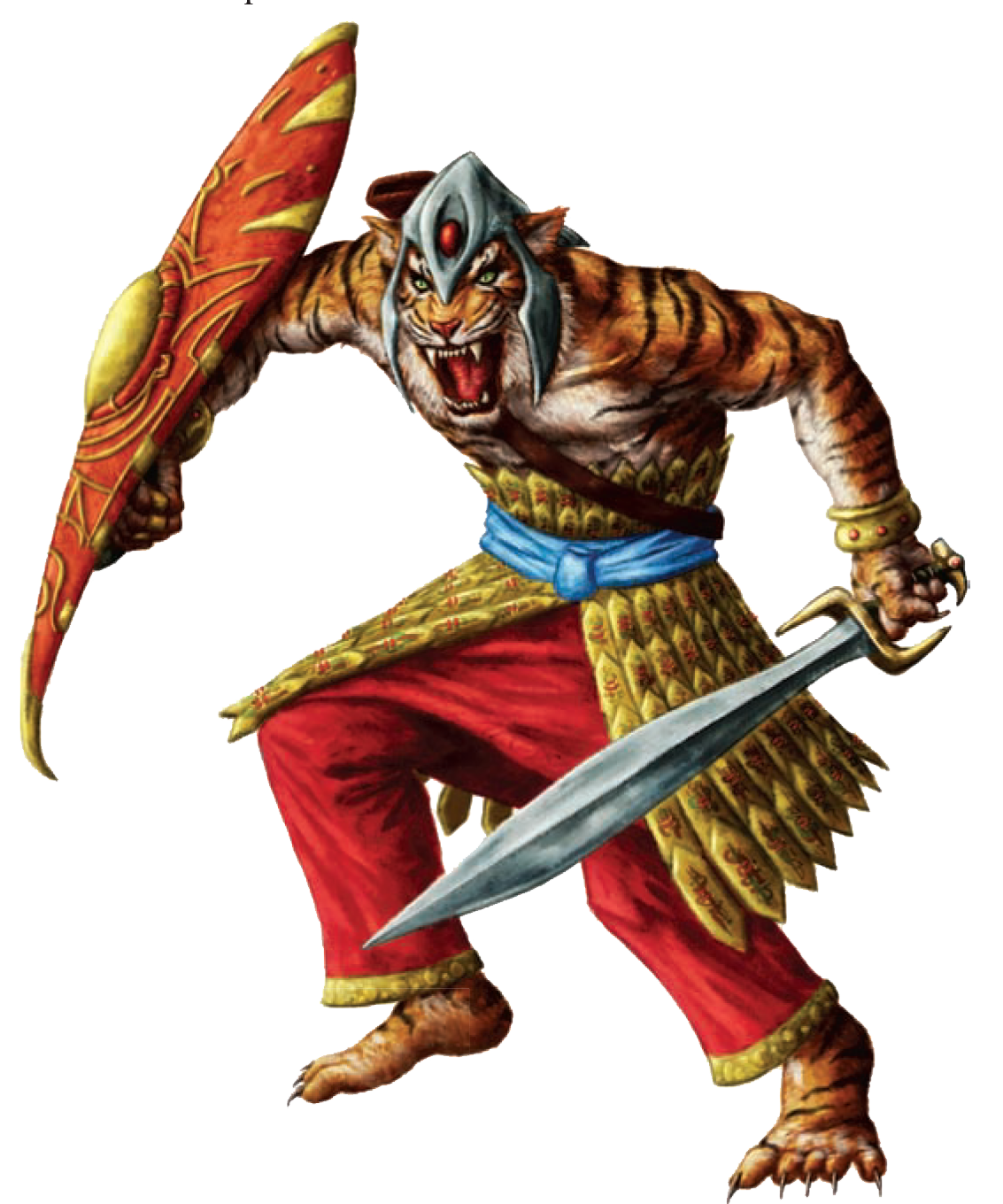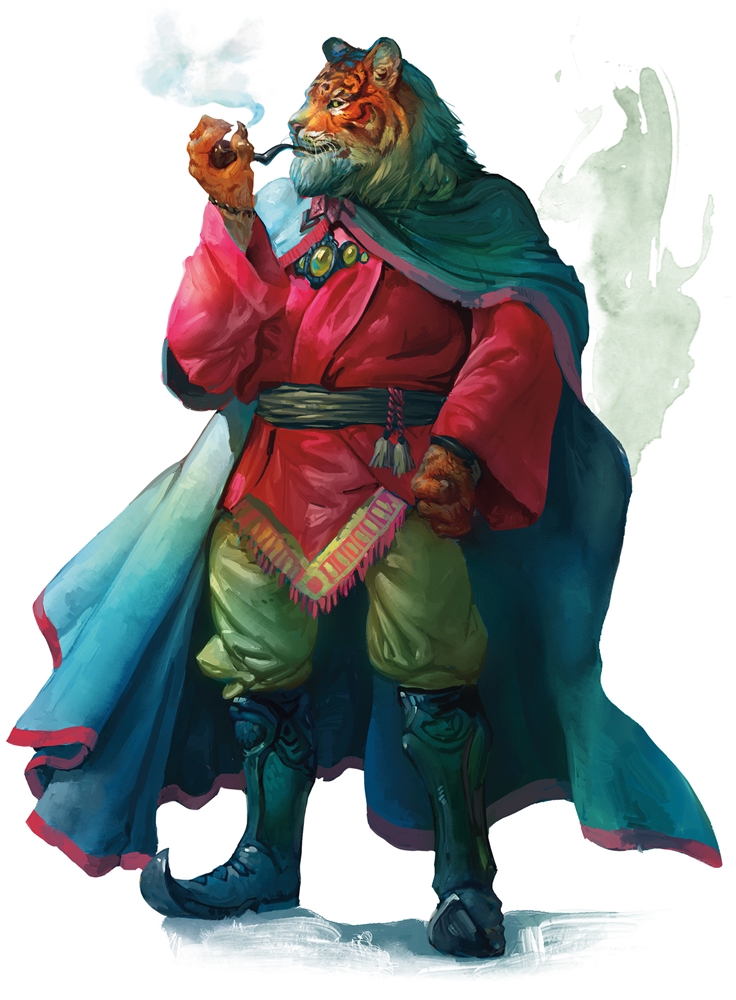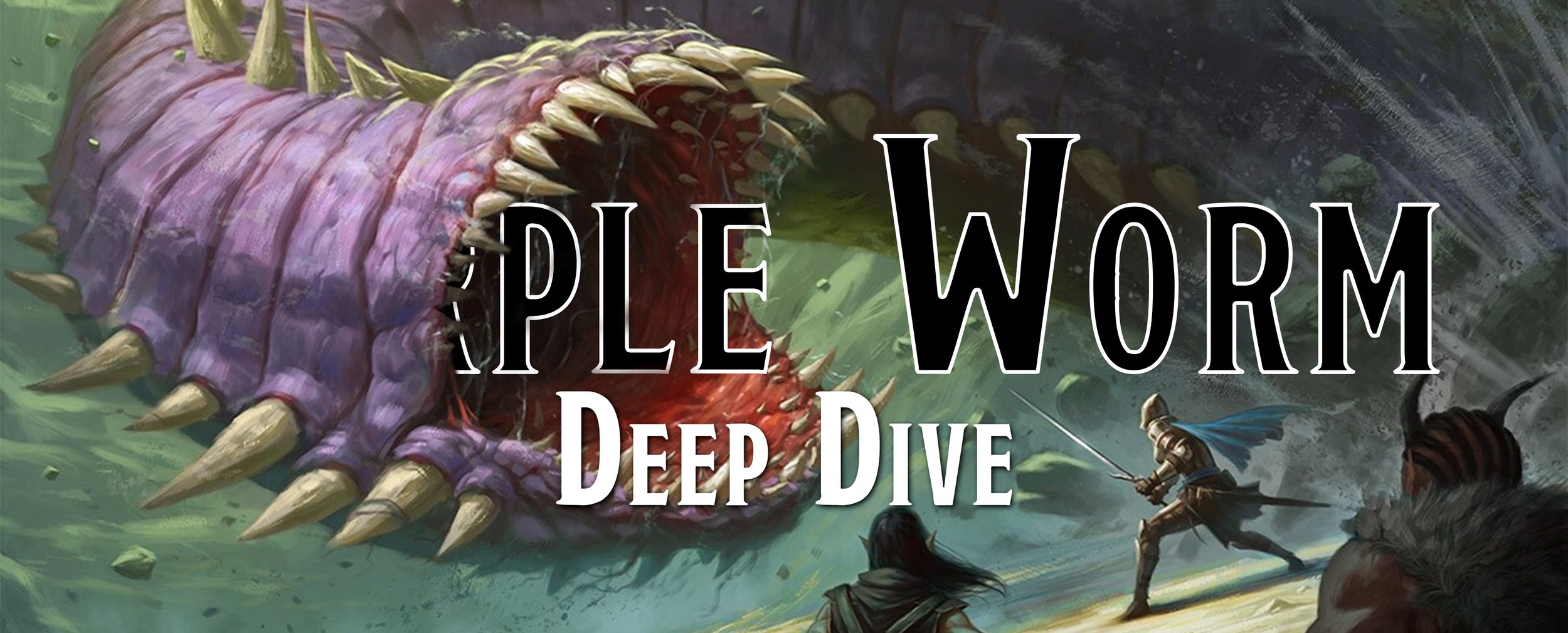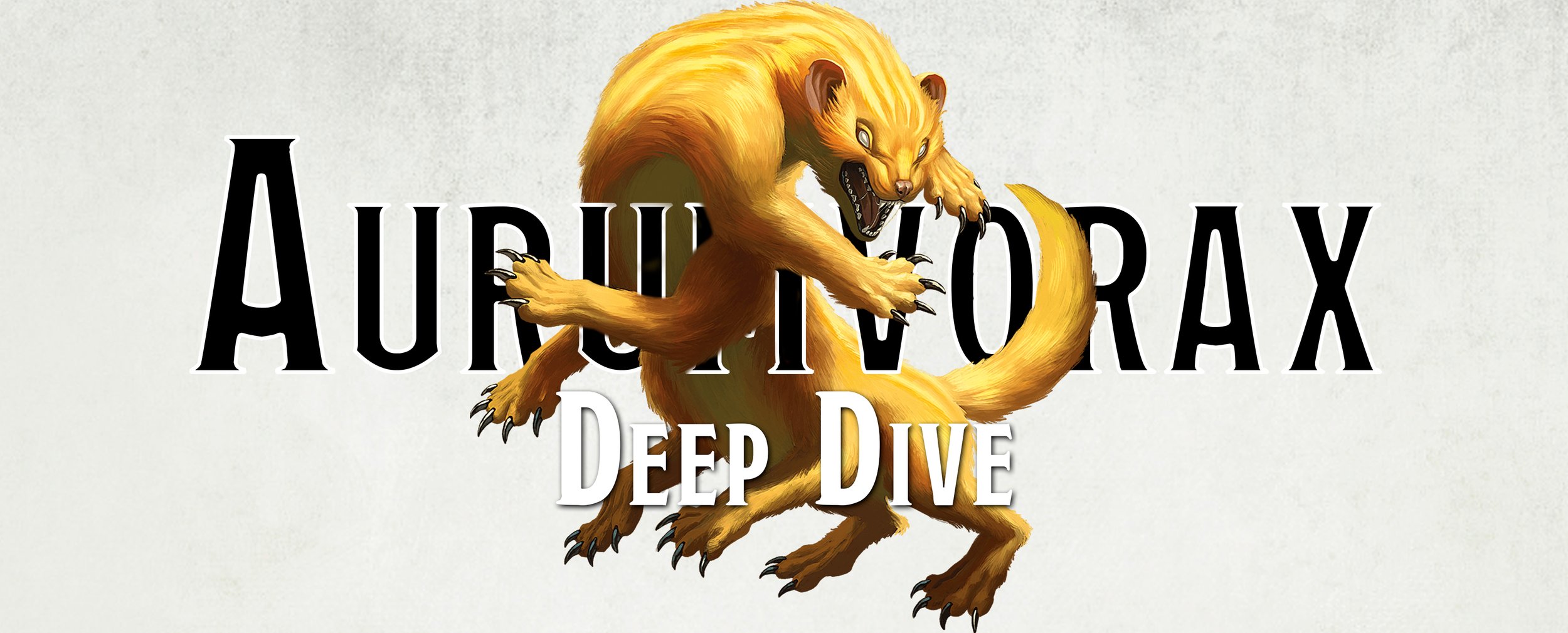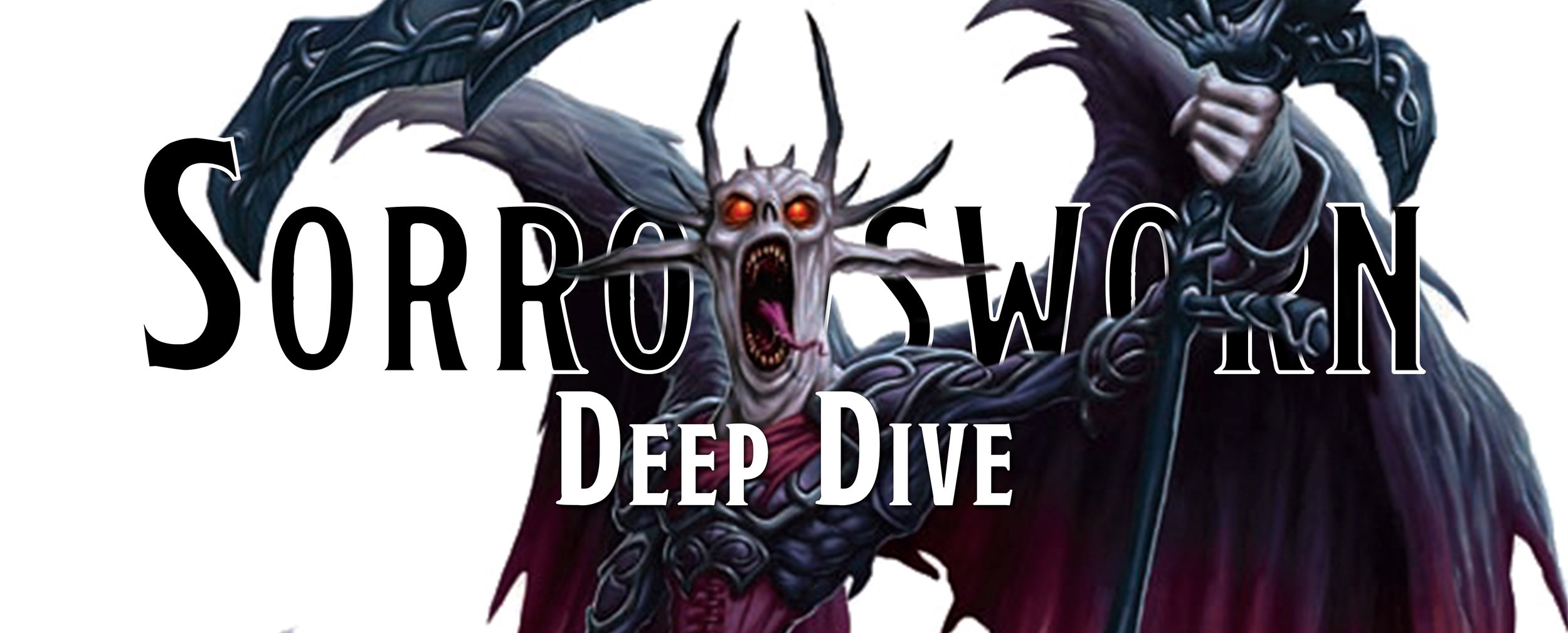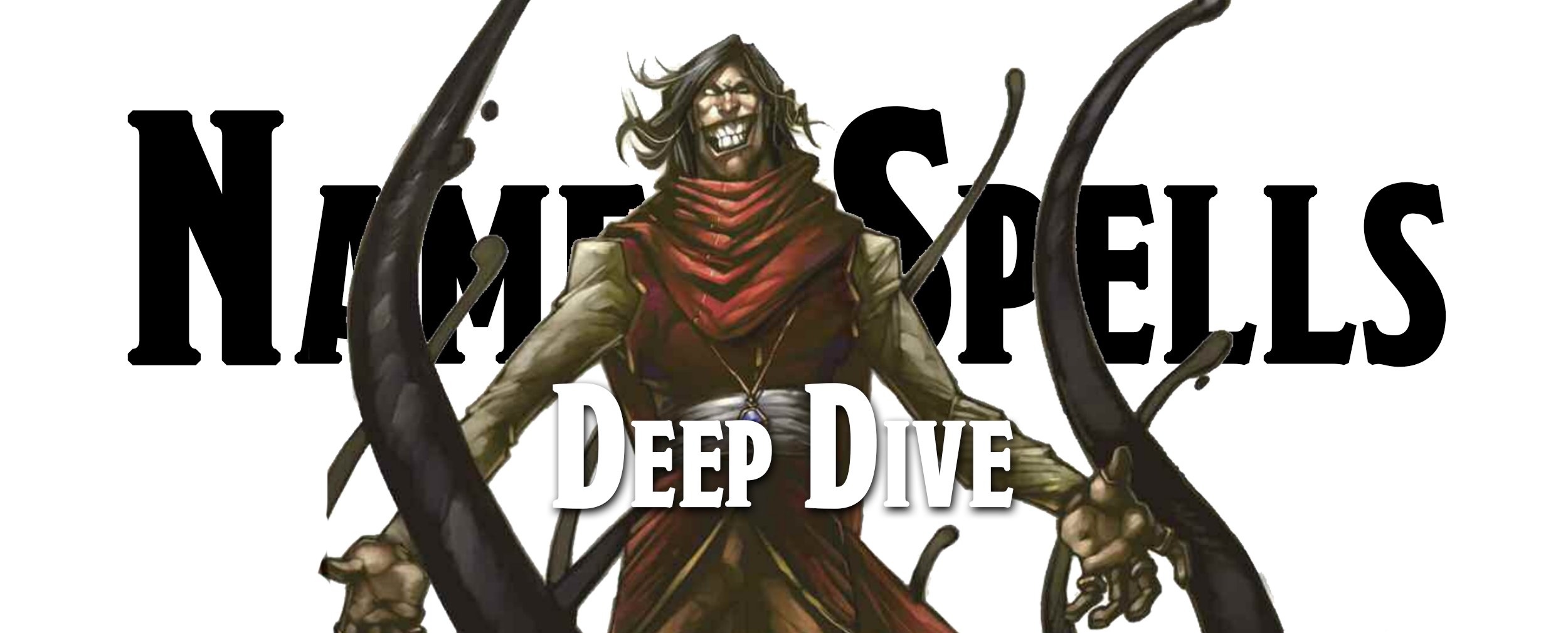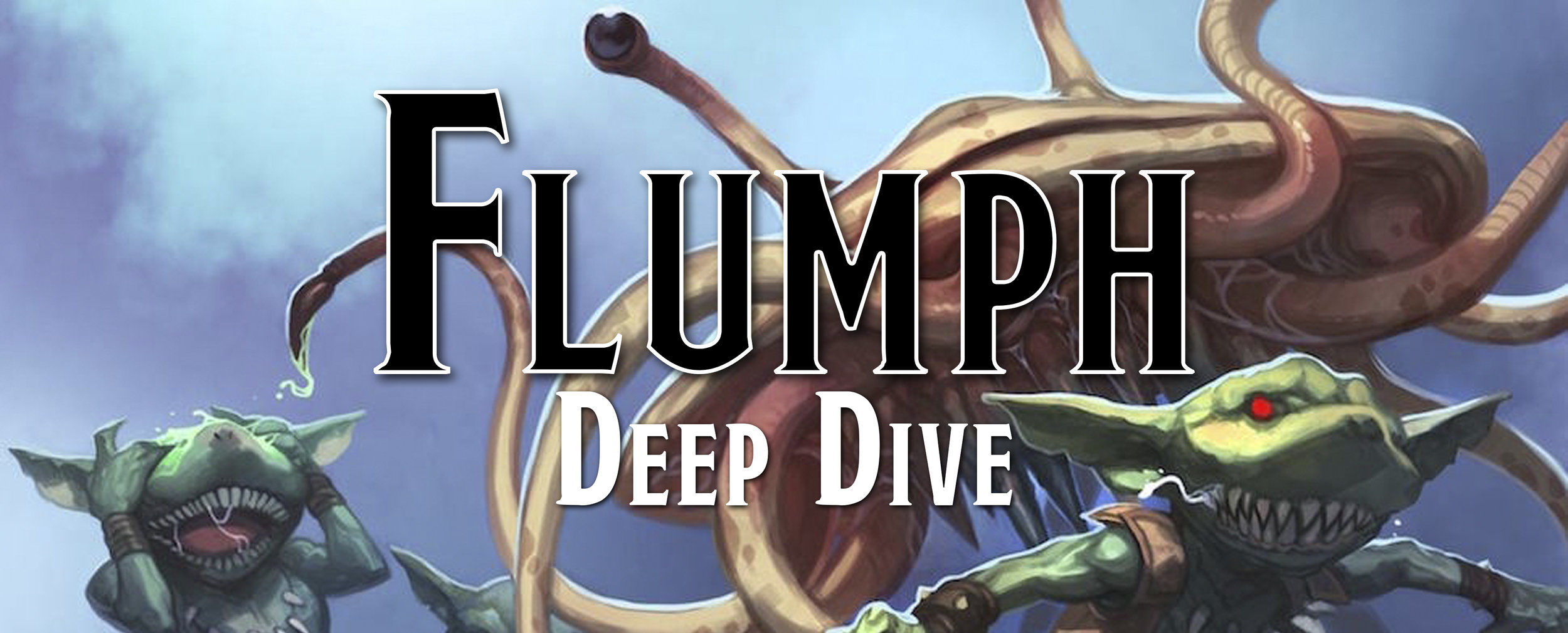Deep Dive - The Rakshasa
The Rakshasa is an interesting creature. They have been included in every edition of Dungeons & Dragons, being developed further and further as the years passed. We haven’t run into them very often and that’s a shame because they are one of those creatures that have endless possibilities on how they can be played.
Rakshasas are mythical demons from the Hindu religion. Made by Brahma, the Hindu god of creation, the Rakshasa immediately turned on their creator and started eating him. Vishnu was the first god to come to Brahma’s aid and the Rakshasa were banished to Earth. In the Hindu religion, they were depicted as fierce-looking and enormous creatures with two fangs and having sharp, claw-like fingernails. These large and vicious creatures who love human flesh and are known to be cannibals. Some Rakshasas are so ferocious, they have been shown with flaming red eyes and hair, drinking the blood of their victims with their palms or from a human skull. They can fly, vanish, and had mastered the power of illusion, which allowed them to change size at will and become any creature they desired. Female Rakshasas were known as Rakshasi and they used their powers of illusion to turn into beautiful women that would seduce their victims. Later on, Rakshasas were incorporated into the Buddhist religion.
One last thing of note about the Rakshasa before we begin… They have some of the best art throughout the editions of any creature we have done a deep dive for… which doesn't exactly set the bar very high.
OD&D - The Rakshasa (Demons of India)
Armor Class: -5
Move: 18/36
Hit Points: 200
Magic Ability: (See Below)
Fighter Ability: 15th Level
Psionic Ability: Class 6
The Rakshasa was first introduced in an official newsletter put out by TSR in 1975, The Strategic Review #5. The first supplement to have the Rakshasa was the Supplement IV: Gods, Demi-Gods & Heroes (1976) and there are several key differences between the two.
In the newsletter, they are slightly weaker though highlight that they can cast Magic-User and Cleric spells, are unaffected by spells of 8th level or lower, and have the powers of ESP to confuse and throw their prey off guard. In the Supplement IV, there is no mention of those abilities but rather that they are so powerful that even gods fear them and they have these powers: shapechange, fight invisible except against gods, regenerate as a troll, crave the taste of human flesh, and cannot refuse a gambling bet. I’m not sure the inability to refuse a gambling bet is a power, but it’s there!
This is our first look at the Rakshasa and it is clear they are going to be total badasses. They fight gods, the regenerate health, eat humans and they can shapechange! It’s the shapechange ability that makes the Rakshasa a truly devastating creature. Shape Change in OD&D is insanely powerful and is a 9th level Magic-User spell that allows you to take on the shape of whatever creature you want, and you can change your form multiple times while under the spell.
The example given in the OD&D spell description makes one realize just how powerful the spell is but it’s not crazy enough. Let’s assume you and your army come across a Rakshasa. As he is a level 15 fighter he can easily pummel the crap out of you but as there are so many of you, the Rakshasa can change into a beholder. As the Rakshasa-beholder begins wiping out your army, you rally your troops and charge the creature. The Rakshasa can then change into a dragon and fly high above your troops. Before you get much of a chance to try and spread your troops, the Rakshasa-dragon dive bombs and with his fire breath lies waste to the rest of your army. For fun, the Rakshasa-dragon can then change into a huge boulder and squish any survivors. The Rakshasa is a complete badass and is probably the type of person that doesn’t look back at explosions when they calmly walk away from them.
Though most gods have the ability to shapechange, so we can’t even begin to imagine what those crazy fights look like.
AD&D - Rakshasa
Frequency: Very rare to Rare
No. Appearing: 1-4
Armor Class: -4
Move: 15”
Hit Dice: 7
% in Lair: 25%
Treasure: F
No. of Attacks: 3
Damage/Attack:1-3/1-3/1-5
Special Attacks: See Below
Special Defenses: See Below
Magic Resistance: See Below
Intelligence: Very
Alignment: Lawful evil
Size: M
Psionic Ability: Nil
Monster Manual, 1977 TSR Inc.
The Rakshas is introduced in the Monster Manual (1977) and is the same information provided in the Strategic Review #5 for OD&D. This means that while they are still powerful, they are nowhere close to the fearsome demon-gods that they were previously. While gods may no longer fear these creatures, you and your party should still be very careful.
The first line of their description is extremely evocative and should be appealing to most Dungeon Masters. It starts with “… these evil spirits encased in flesh are spreading…” and goes on to tell about how they love human flesh, that they have ESP and are masters of illusion. In the Monster Manual, there is no mention of their physical characteristics, though a picture is given of a tiger that can presumably walk on two feet. This cool-cat is sitting at a table, incense burning and lighting a long pipe. It really provides a cool feel for the Rakshasa, though it is an interesting choice as Rakshasas do not have a uniform physical look to them according to Hindu myths.
Dragon Magazine #84, 1984 TSR Inc.
In Dragon Magazine #84 (1984) they provide an article going over the history of the Rakshasa as well as strategies and two additional Rakshasas in case the one in the Monster Manual wasn’t enough to kill your party. The picture they provide is more of a hulking ape with backward claws laced with poison. The article, and the Monster Manual, goes on to talk about how a Rakshasa will use their ESP power to confuse their prey and attack them at their weakest… which is good as the physical attacks of a Rakshasa aren’t much to talk about.
A Rakshasa gets three attacks per round, but their melee attacks are only claws and a bite. They can cast spells, but only Magic-Users spell up to 3rd level and 1st level Cleric spells. While it’s pretty disappointing that their attacks are so weak, they more than makeup for it in their defenses. With an AC of -4, that puts the Rakshasa on the same level as greater demons as hitting a -4 AC in AD&D is incredibly hard. To make matters worse, nonmagical weapon attacks are useless, and a magical weapon that is less than +3 will only do half damage.
Now, our Magic-User, who is standing in the back with their d4 hit dice might think this is their time to shine. Maybe realizing this isn’t an enemy that a fireball will solve, they pull out their spellbook and decide that its time to pull out the big guns and casts disintegrate on the Rakshasa. Unfortunately, the spell has no use as the tiger-demon creature is laughing at them. Spells under 8th Level have no effect on the Rakshasa, meaning that all cleric and druid spells have no effect. Hopefully, they have some really good magic weapons on them.
The Cleric, that underrated and under-appreciated member of the party, has the silver bullet to save our friends, and it’s the simple 1st level Bless spell. In an oddly specific description in the AD&D Monster Manual, it states that crossbow bolts blessed by a cleric will kill the Rakshasa, presumably in one hit. The spell has nothing to do with attacks but for some reason it works.
2e - Rakshasa
Climate/Terrain: Tropical or subtropical forest, jungle, or swamp
Frequency: Rare
Organization: Solitary
Activity Cycle: Night
Diet: Carnivore
Treasure: F
Intelligence: Common: Very (11-12)
Alignment: Lawful Evil
No. Appearing: 1-4
Armor Class: -4
Movement: 15
Hit Dice: 7
THAC0: 13
No. of Attacks: 3
Damage/Attack: 1-3/1-3/2-5
Special Attacks: Illusion
Special Defenses: +1 or better magic weapon to hit
Magic Resistance: Special
Size: M 6’ Tall
Morale: Champion(15-16)
XP Value: 3,000
Monstrous Compendium Volume One, 1989 TSR Inc
Released in Monstrous Compendium Volume One (1989) and then again in the Monstrous Manual (1993), the 2nd edition expands on the Rakshasa, giving a lot more detail about its appearance, ecology and skill set. We are also introduced to three more Rakshasas of varying power… though none of these Rakshasas are creatures you want to mess with.
While it is stated in the opening paragraph that no one knows where they originated from, there is a guess that they are the “… embodiment of nightmares.” Typically our nightmares don’t consist of demon-tigers smoking a pipe, but if they did we are confident it would be scary. We are given more information about their physical characteristics, more specifically that Rakshasas have no uniform characteristics though most resemble various humanoid beasts, typically of tigers or apes. Furthermore, most stand at about 6 to 7 feet tall, its very common for them to have hands with palms that curve backward, and the more powerful Rakshakas have multiple heads. They also prefer to wear human clothing of the highest quality, all the while looking down disdainfully and even sneering at your adventuring clothes… we presume.
Monstrous Manual, 1993 TSR Inc
The only problem we have with their description is that there isn’t much reason given for the palms to be curving backward, and no lore or history explains why their palms do it. We suppose it could be the drugs they were smoking back then, but it may have just been an artistic choice so that they didn’t just look like Weretigers.
Rakshasas are no longer portrayed as solitary wanderers, but part of a very strict caste system where you are born is where you will remain for your entire existence. Of course, the women are stuck at the bottom as consorts, honored only for how faithful they are and how good their children are at fighting, which goes without saying is bullshit. Above them are the regular male Rakshasas, with the same stats as the female Rakshasas. Going one tier up are the Ruks, also known as Knights, who are led by the Rajahs, also known as Lords, who act as clan leaders. The highest rank is the Maharajahs who oversee several smaller clans or one really powerful clan. What’s really the kicker here is that because they are spirits that inhabit flesh, every century they replenish their numbers with the same amount of Rakshasas who died, basically allowing them to be somewhat immortal.
Combat abilities don’t change too much with their primary way of lulling their victims is with the use of ESP and illusions. Their melee attacks stay fairly weak, but they still have the ability to cast spells. The higher up the caste system you go though, the more powerful spells you can cast. All Rakshasas can cast up to 3rd Level wizard spells and 1st Level priest spells, with the stronger Maharajahs being able to cast up to 7th level wizard spells and 5th Level priest spells.
Not too shabby once you start fighting the higher level Rakshasas, though even the lower ones still have their immunities to nonmagical weapons and to 8th Level spells or lower. On the other hand, no matter how powerful they get, if you hit them with a single blessed crossbow bolt, they are killed instantly.
So overall, not much changes for our common Rakshasa. But with the introduction of the three new greater Rakshasas, you may want to avoid stumbling into a clan stronghold. Either that or be able to run really fast.
3e/3.5e - Rakshasa
Size/Type: Medium Outsider (Native)
Hit Dice: 7d8+21 (52 hp)
Initiative: +2
Speed: 40 ft. (8 squares)
Armor Class: 21 (+2 Dex, +9 natural), touch 12, flat-footed 19
Base Attack/Grapple: +7/+8
Attack: Claw +8 melee (1d4+1)
Full Attack: 2 claws +8 melee (1d4+1) and bite +3 melee (1d6)
Space/Reach: 5 ft./5 ft.
Special Attacks: Detect thoughts, spells
Special Qualities: Change shape, damage reduction 15 / good and piercing, darkvision 60 ft., spell resistance 27
Saves: Fort +8, Ref +7, Will +6
Abilities: Str 12, Dex 14, Con 16, Int 13, Wis 13, Cha 17
Skills: Bluff +17, Concentration +13, Diplomacy +7, Disguise +17 (+19 acting), Intimidate +5, Listen +13, Move Silently +13, Perform (oratory) +13, Sense Motive +11, Spellcraft +11, Spot +11
Feats: Alertness, Combat Casting, Dodge
Environment: Warm marshes
Organization: Solitary
Challenge Rating: 10
Treasure: Standard coins; double goods; standard items
Alignment: Always lawful evil
Advancement: By character class
Level Adjustment: +7
Monster Manual, 2003 WotC
The Rakshasa is released in the 3e Monster Manual (2000) and the 3.5e Monster Manual (2003) with not many changes from the older editions. Though it has one major change in 3.5e that wasn’t present in 3e… they lose their Spell Immunity and instead get Spell Resistance, which pretty much sucks and is a pretty hard nerf on our favorite demon-tigers.
Despite that insult to the Rakshasas, they still make it out pretty well in 3e. Their art looks good, though the Monster Manual artwork shows them with the wrong hands as they specify in the lore that all Rakshasas have their palms on top of their hands which they state that: “While it doesn’t detract from the creatures manual dexterity, it makes a rakshasa look very disturbing to those unfamiliar with the creature.” The Monster Manual just can’t catch any breaks!
The Monster Manual goes on to clarify that all Rakshasas look like regular humanoids except they have tiger heads and a layer of tiger fur over their bodies. They still love their fancy clothes and find close combat to be ignoble, preferring to allow minions or their spells to keep the fighting away from them. Also, they no longer have to drop their shape changed form if they decide to attack you, and can stay in whatever form they wish, though they lose their claw and bite attacks… which aren’t that great, to begin with.
Another change, which is probably for the best, is that a blessed crossbow bolt isn’t just a one-hit, one kill. Well, in 3e it is, but 3.5e the Rakshasa gets Damage Resistance 15/good and piercing, which just means that they are going to resist all damage unless it is taken from a good-aligned weapon that deals piercing damage… like from a blessed crossbow bolt… Well, at least it won’t kill them outright.
Monster Manual III, 2004 WotC
In the Monster Manual III (2004) gives us two more Rakshasas to send after our party - The Ak’chazar and the Naztharune. The Ak’chazar are masters of necromantic magic while the Naztharune are the assassins. The Ak’chazar are white-headed tigers that are master manipulators and they travel the planes in search of undead minions who they can force into slavery and places of power that they can control. Preferring to work behind the scenes to consolidate their power, they use a network of spies, assassins, and undead to bring their plans to fruition. Naztharune use their abilities as skilled rogues to kill their victims, sneaking up on their prey and killing them in close quarters and appear to be black tigers of slight build.
Monster Manual III, 2004 WotC
What sets the Rakshasa apart in this edition is there is a great deal of information found outside of the Monster Manual. The Eberron campaign setting gives us the Zakya Rakshasa. These mighty warriors ruled Eberron for thousands of years in ancient times. They have the same abilities as the common Rakshasas found in the Monster Manual with a few important changes. While they have limited spell-like abilities, the Zayka can turn their hands backwards, allowing them to wield weapons like a normal humanoid would. They are known as accomplished fighters and actually like fighting close quarters.
Taking the Eberron Rakshasa lore one step further, Rakshasa Dark Lords are introduced in Dragon Magazine #337 (2005). These Overlords do not seek power but wish to release their masters, who were imprisoned thousands of years ago, and linger in a dreamlike state, waiting to be released. The Overlords are immensely powerful, for example, the Overlord Kashtarhak, the Voice of Chaos is a CR 24 creature, with 29 Hit Dice and can cast seven 9th Level spells a day. If these are the servants of greater masters, let us all hope they never succeed in freeing them.
Our final piece of lore for the Rakshasa comes in Dragon Magazine #326 (2004) which does an Ecology of the Rakshasa article. While there isn’t much new information that hasn’t been discussed in previous editions, there are a few interesting items that can be gleaned. Rakshasas love destroying the lives of humans even more than eating them. When they enter into a new territory they will spend years gathering power and influence in the area, doing so using a variety of different personas and disguises. As their strength grows, they will demand more and more from their followers, such as their wealth, power and freedom. The Rakshasa will also develop a network of spies and easily corruptible politicians and officials during this time and when they feel the time is right, they will make their move to obtain greater power by taking over the local thieves’ guild and mercenary units. If they ever find another Rakshasa in their territory, a shadow war will wage between the two until one is the victor.
4e - Rakshasa
Rakshasa Warrior - Level 15 Warrior
Medium natural humanoid XP 1,200
Initiative +13 / Senses Perception +16; low-light vision
HP 142; Bloodied 71
AC 31; Fortitude 29, Reflex 28, Will 28
Speed 6
> Longsword (standard; at-will) - Weapon. The Rakshasa warrior makes two attack rolls and keeps the better result; +21 vs AC; 1d8+5 damage, and the target is marked until the end of the rakshasa’s next turn
Claw (standard; at-will) +21 vs. AC; 1d8+5 damage
Tiger Pounce (immediate reaction, when a marked enemy within 5 squares of the rakshasa warrior shifts; at-will). The rakshasa shifts to the nearest square adjacent to the enemy and makes a basic attack against it.
Deceptive Veil: (minor; at-will) The rakshasa warrior can disguise itself to appear as any Medium humanoid. A successful Insight check (opposed by the rakshasa’s Bluff check) pierces the disguise.
Alignment Evil / Languages Common
Str 20 (+12) | Dex 18 (+11) | Wis 18 (+11) | Con 14 (+9) | Int 12 (+8) | Cha 14 (+9)
Equipment scale armor, heavy shield, longsword
Monster Manual, 2008 WotC
Introduced in the Monster Manual (2008), the Rakshasa is given little information but several new forms it can take. The Rakshasa are still known for their cleverness and maliciousness, but also for their desire for luxury items. They all take on the form of various feline creatures and can use their innate magical ability to disguise themselves to look like other humanoids.
While the Rakshasa would still rather manipulate others, there are several Rakshasas that are fierce and ruthless in combat, getting up close with sword and daggers. Though if their weapons aren’t available, their claws can do just as much damage and might even blind the target depending on who is behind the claws.
Monster Manual, 2008 WotC
We also get more information on the lore of the Rakshasa and more specifically where they come from. Some scholars theorize that the Rakshasa is from the Abyss and are the spawn of demons, of course, the Rakshasas aren’t really into that and they assert that their species could never have such degenerate origins… though they are pretty cruel creatures, so they are probably from the Abyss.
Now, another big thing in 4e is that there is no information on any type of Spell Resistance, and quite frankly they don’t really feel special anymore. They just seem like a generic race of feline creatures that happen to have backwards palms and can disguise themselves. The only saving grace for them is that they are virtually immortal as their spirits can regenerate. According to the Monster Manual, they are: “… fiendish spirits veiled in flesh, rakshasas are bound to the world.” As such, they will reform wholly after a few days, weeks or even years, and while that might be a while they are going to come back. When they finally do reincarnate, they are extremely pissed off as it is painful for them. Their one goal now is to find the person that ‘killed’ them, and make them suffer… which typically includes death. The only way to truly get rid of a Rakshasa is using some sort of specially blessed weapon that pierces their heart… like a crossbow bolt.
Monster Manual, 2008 WotC
There are five types of Rakshasas introduced in the 4th edition; the Warrior, Archer, Assassin, and Noble. Each one has a special ability unique to it.
Warrior - Tiger Pounce. When a creature is hit, the warrior marks the target and can keep following it around the battlefield.
Archer - Ghost Arrow. The archer can shoot a deadly arrow that stops the target from being able to heal.
Assassin - Phantom Distraction & Shadow Form. These Rakshasas can blend into merge into the shadows, allowing them to move through obstacles and creatures. They can then daze targets, which allows them to make even more attacks.
Noble - Frightful Phantom & Phantom Image. These nobles take on the earlier editions of the Rakshasas in that they dislike to fight in close quarters. They will try to scare other creatures away from them, and if that doesn’t work, they will use their ability to blind creatures and cause attacking targets to roll two attack rolls, taking the worse result.
Dread Knight - Knight’s Move & Triple Attack. Everyone wants to be able to fly, but the Dread Knight really can. It will fly up to its target and then use its triple attack ability to hit them three times.
5e - Rakshasa
Rakshasa / Medium fiend, lawful evil
Armor Class 16 (natural armor) / Hit Points 110 (13d8+52)
Speed 40 ft.
Str 14 (+2) | Dex 17 (+3) | Con 18 (+4) | Int 13 (+1) | Wis 16 (+3) | Cha 20 (+5)
Skills Deception +10, Insight +8
Damage Vulnerabilities piercing from magic weapons wielded by good creatures
Damage Immunities bludgeoning, piercing, and slashing from nonmagical attacks
Senses Darkvision 60 ft., passive Perception 13
Languages Common, Infernal
Challenge 13 (10,000 XP)
Limited Magic Immunity. The rakshasa is immune to spells of 6th level or lower unless it wishes to be affected. It has advantage on saving throws against all other spells and magical effects.
Innate Spellcasting. The rakshasa's innate spellcasting ability is Charisma (spell save DC 18, +10 to hit with spell attacks). The rakshasa can innately cast the following spells, requiring no material components:
At will: detect thoughts, disguise self, mage hand, minor illusion.
3/day each: charm person, detect magic, invisibility, major image, suggestion.
1/day each: dominate person, fly, plane shift, true seeing
Multiattack. The rakshasa makes two claw attacks .
Claw. Melee Weapon Attack: +7 to hit, reach 5 ft., one target.Hit:9 (2d6 + 2) slashing damage, and the target is cursed if it is a creature. The magical curse takes effect whenever the target takes a short or long rest, filling the target's thoughts with horrible images and dreams. The cursed target gains no benefit from finishing a short or long rest. The curse lasts until it is lifted by a remove curse spell or similar magic.
Monster Manual, 2014 WotC
And now at 5th edition, the Rakshasa is introduced in the Monster Manual (2014) and we back to only a single type of Rakshasa, who appears to be a very well-dressed tiger-demon smoking a long pipe, with backwards hands. Sadly, there is very little new information on the Rakshasa though we do learn that when they die they return to the Nine Hells where they reform over the course of months of years… and they are listed as Fiends… So it looks like they weren’t demon spawn after all, but devil spawn! Now we can rest easy at night!
This is backed up by the fact that it was actual devils creating a dark ritual to “… free their essence from their fiendish bodies to escape the Lower Planes.” Which I’m not sure worked out super great for them as there is no mention as to whether the Rakshasas remember their time as being a powerful devil, though they do hold a grudge against any creature that kills them on the Material Plane, so it’s possible they remember the time when they were once devils.
The current rendition of the Rakshasa is pretty lackluster, they have a fairly weak claw attack though its ability to cause nightmares and keep you from gaining the benefits of a short or long rest is pretty powerful… except casting Remove Curse removes it completely. If you fought a Rakshasa, and lived, you probably have an easy source of Remove Curse. While there is no mention of blessed crossbow bolts doing extra damage, they are now vulnerable to all attacks from good creatures wielding magical piercing weapons. Which is just one more reason to always play Chaotic Good!
The 5th edition Rakshasa is pretty lackluster and brings very little new information to the Dungeons & Dragons lore. The Rakshasas started off as these powerful almost godlike beings to clever creatures who formed shadow networks of spies to some sort of generic tiger race and back to the shadowy devil that is holding all the strings.
If you enjoy our Deep Dive series consider
supporting us on Patreon and following us on Twitter!









